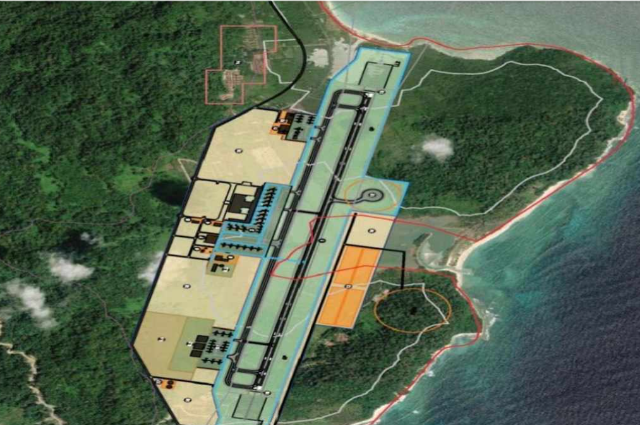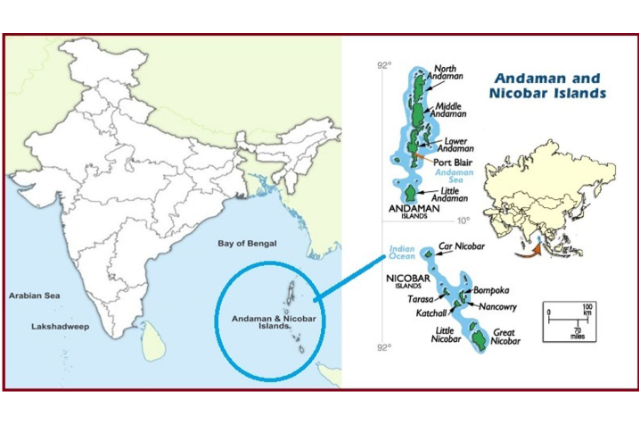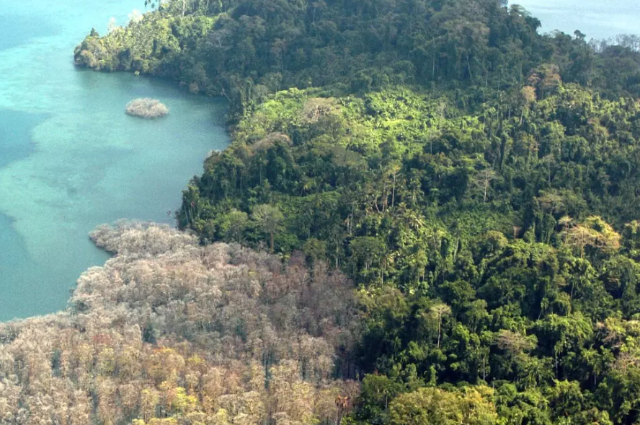
Introduction
India is embarking on an ambitious journey to transform the Andaman and Nicobar Islands into a modern metropolis, with a staggering investment of ₹75,000 crore. The government's vision positions this development as a potential financial and infrastructural hub akin to Hong Kong. However, this plan raises several pertinent questions: Why Andaman and Nicobar? Why develop a remote, ecologically rich region instead of focusing on existing metropolitan areas? What are the long-term implications of such a large-scale transformation? This essay critically examines the rationale, feasibility, and potential impact of this ambitious project while analyzing its social, economic, and environmental consequences.


LOCATION OF ANDAMAN AND NICOBAR ISLAND
Why Andaman and Nicobar?
The Andaman and Nicobar Islands comprise 836 islands, of which only 31 are inhabited. The region is home to indigenous tribes, some of whom have had little to no contact with modern civilization. Given India's 28 states and 8 Union Territories, each with its own development needs, one must question the government’s decision to focus on these remote islands rather than investing in well-established metropolitan cities.
A key factor driving this project is strategic significance. The islands are located in the Bay of Bengal, near crucial international maritime trade routes. Strengthening infrastructure and connectivity here would not only boost trade but also enhance India's naval presence in the Indo-Pacific region. Additionally, the government sees an opportunity to create a global financial hub that could attract multinational corporations and investors.
The Challenge of Development in a Remote, Forested Area
One of the most controversial aspects of this project is its location. The islands are ecologically rich, with dense rainforests covering approximately 90% of Little Andaman. This biodiversity hotspot is home to endemic species and delicate ecosystems that have remained largely untouched.
The development plan includes large-scale infrastructure projects such as airports, ports, and smart cities. However, such transformations pose significant environmental risks, including deforestation, loss of biodiversity, and disruption of tribal communities. The challenge, therefore, is to strike a balance between economic progress and environmental conservation.

DENSE FOREST OF ANDAMAN AND NICOBAR ISLAND
Economic and Strategic Advantages
The economic potential of a modernized Andaman and Nicobar is vast. A well-planned metropolis could become a thriving center for tourism, trade, and technology. The pristine beaches, coral reefs, and diverse marine life make the islands an attractive destination for luxury tourism. Improved connectivity could bring in high-value tourists, boosting local employment and revenue generation.
Additionally, with India aiming to establish itself as a major player in the Indo-Pacific, the islands' strategic location provides a strong geopolitical advantage. Developing a world-class port could facilitate increased maritime trade and strengthen India’s defense capabilities. This would help counterbalance China's growing influence in the region, especially given its investments in neighboring countries' port infrastructure.
Environmental and Social Concerns
While economic and strategic benefits are evident, the project faces serious environmental and social concerns. Large-scale construction could lead to deforestation, threaten wildlife habitats, and alter the ecological balance. Coastal erosion and rising sea levels due to climate change further complicate the viability of such a grand-scale urbanization plan.
Moreover, the indigenous tribes residing on the islands could be severely affected. Tribes such as the Onge, Jarwa, and Sentinelese have lived in isolation for centuries, preserving unique cultures and ways of life. Rapid modernization and an influx of outsiders could disrupt their social fabric, leading to displacement and cultural erosion.
As renowned environmentalist Rachel Carson once said, "In nature, nothing exists alone." Any disruption to the delicate ecological balance of the Andaman and Nicobar Islands could have cascading effects, impacting not just the local environment but global biodiversity as well.
Comparative Analysis: Hong Kong vs. Andaman and Nicobar
The government’s comparison of this project to Hong Kong invites scrutiny. Hong Kong evolved as a financial hub due to historical factors, business-friendly policies, and its strategic position as a gateway to China. It already had a dense urban population, well-established legal frameworks, and strong international trade connections.
In contrast, Andaman and Nicobar lack the foundational infrastructure needed for rapid urbanization. The population density is significantly lower, and the economy is not yet integrated into global financial networks. Expecting a similar
transformation requires careful long-term planning and phased development rather than an aggressive, large-scale shift.
Nobel laureate Amartya Sen emphasized that "Development is about transforming the lives of people, not just transforming economies." This perspective is particularly relevant in the context of Andaman and Nicobar. Economic growth must not come at the cost of displacing indigenous communities or harming the environment.
Alternative Approaches to Development
Instead of pursuing a radical transformation, a more sustainable approach could involve:
● Eco-tourism: Developing environmentally friendly tourism models that generate revenue while preserving natural beauty.
● Marine Economy: Investing in fisheries, sustainable aquaculture, and marine biotechnology industries.
● Renewable Energy Projects: Harnessing solar and wind energy to make the region a clean energy hub.
● Selective Urbanization: Developing select pockets of the islands into smart, self-sustaining townships rather than a full-scale metropolitan city.
UNESCO has highlighted that "Sustainable development is the pathway to the future we want for all." Implementing eco-friendly alternatives ensures economic progress without irreversible environmental damage.
The Role of Policy and Governance
Effective governance is crucial for the success of any large-scale development project. Transparent policymaking, environmental impact assessments, and public consultations should be integral to the planning process. Moreover, integrating
Indigenous voices in decision-making could help mitigate the risks of cultural erosion and displacement.
India’s experience with the development of coastal cities like Mumbai and Chennai shows that rapid urbanization often leads to unplanned expansion, resource depletion, and environmental degradation. Learning from past mistakes, the government must prioritize sustainable urban planning in Andaman and Nicobar.
Conclusion
The Indian government's vision to develop Andaman and Nicobar into a global metropolis presents both opportunities and challenges. While the economic and strategic advantages are compelling, the project must address serious environmental and social concerns. A well-balanced approach that integrates sustainable development with modernization could unlock the region's potential without compromising its rich biodiversity and indigenous heritage.
As Mahatma Gandhi aptly stated, "The earth provides enough to satisfy every man's needs, but not every man's greed." India must approach this development with a sense of responsibility, ensuring that economic ambitions do not come at the cost of ecological and cultural destruction.
Ultimately, the success of this project will depend on how effectively India navigates the delicate balance between progress and preservation. With careful planning, transparent governance, and a commitment to sustainability, Andaman and Nicobar can emerge as a model of responsible development for the 21st century.
